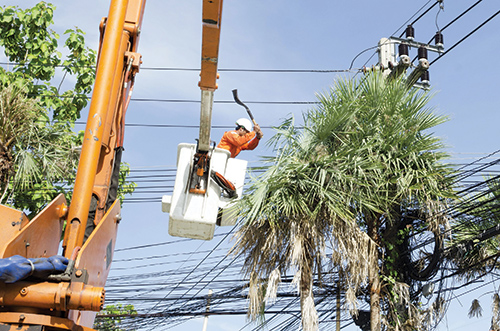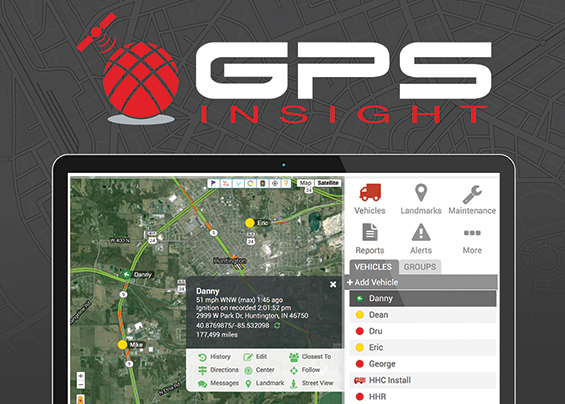Automatic Vehicle Location (AVL) technology is no longer in the ‘nice to have’ category of needs and wants for companies in the electric energy industries; it is a very necessary tool for business intelligence. Advanced AVL systems are being adopted by electrical energy fleets to deploy resources more efficiently, increase safety on the job, reduce fuel costs, and more.
AVL systems have the ability to solve unique challenges for the electrical energy industry due to their adaptable functionality. Some of the challenges electrical have been able to solve with AVL include increasing technician safety on remote job sites, identifying first responders quickly during an emergency, alerting drivers of hazardous job sites, measuring true idle time to reduce fuel costs, and improving response times during power outages.
By selecting an AVL provider that has the ability to adapt its existing functionality or create custom features to solve unique business challenges, electrical energy fleets will unlock incredible ROI and won’t want to operate their fleet without it.
Verify Driver Safety during a Long Stop
Electrical work can be a dangerous job, so it is important for electrical energy fleets to know their technicians are safe while on remote job sites. With the use of an AVL system, fleet managers can verify their technicians’ well-being during long stops. Knowing about longer than usual stops will increase safety because it will alert management if a driver may be experiencing an emergency. By setting a long stop alert, managers will receive an alert when a vehicle has been stopped for a longer threshold of time than a job should typically take to complete.

Once management is aware that a technician may be in need of assistance, they can reach out by phone or send a message to their navigation device to see if they need help. If the driver indicates that they are in a dangerous situation, or that they are experiencing maintenance issues with their vehicle, management is able to dispatch police or a nearby first responder to the vehicle’s current location.
Identify First Responders
If a technician is in a dangerous situation or is injured, it is important to have the ability to quickly identify first responders in the area. In this use case, electrical cooperatives need to utilize an AVL system for more than just identifying the closest vehicle to the injured technician; they need to identify the closest vehicle with a trained first responder.
For this unique challenge, electrical energy fleets can work with an AVL provider to create selectable vehicle icons on real-time mapping to distinguish their first responders. Having custom icons appear on the map will allow dispatchers to easily identify which first responder is nearest to the technician in need of assistance.
Panic Switch
It is a significant safety hazard if a technician finds themselves in a dangerous situation on a job site and is unable to access their cell phone. For instance, if a vehicle catches fire due to a spark from a broken power line and the technician’s cell phone is in the cab of the vehicle, they will be completely stranded without a way to call for help.
To solve this challenge, electrical energy fleets can provide a panic switch to their technicians so they are able to notify management if they are in need of assistance. The panic button can be attached to the driver’s key chain so it is easily assessable in the event of an emergency. By pressing the panic button, management will be notified that the driver is in need of assistance and can use the AVL system to locate their vehicle’s current location to send assistance right away.
Alert Drivers of Hazardous Locations
Another unique challenge for electrical energy fleets are hazardous work sites. For electrical energy fleets that do not use AVL technology, technicians arrive at a jobsite unaware of what they will find, which is unsafe for the technician and is a liability for electrical cooperatives. To ensure the safety of technicians, electrical energy fleets can use an AVL system to landmark known hazardous job sites.
By creating a landmark, or geo-fence, around the hazardous job site, electrical energy fleets will be able to ensure technicians take the appropriate precautions before entering the job site. Alerts can be associated with hazardous landmarks and sent straight to technicians’ cell phones to notify them of what they should be aware of as soon as they enter these geo-fences.
Monitor PTOs
On the arm of actuated bucket truck, it is dangerous to drive with the Power Take-Off (PTO) switch engaged, which is activated when a bucket is raised for a technician to work on power lines. To increase safety, it is important to verify the arm is lowered all the way back down into secure position while driving. To prevent this dangerous situation, electrical cooperatives can use an AVL system to setup PTO alerts to notify technicians if they are driving with the PTO switch engaged.
Monitor True Idle Time
Electrical energy fleets that are actively monitoring idle time to reduce fuel costs should exclude ‘work idle time’ to only receive alerts for ‘curb idling,’ when a truck is not being utilized for a work function. Since a bucket truck’s engine usually needs to be turned on to operate the bucket, idling during this time should not be included in curb idle time. Work idle time can easily be excluded from alerts and reports by selecting the ‘exclude PTO idling’ option within an alert or report setup. Receiving alerts for curb idle time will notify drivers to turn off their engine, helping electrical energy reduce unnecessary fuel expenses.
Quicker Response Times During Outages
Advanced AVL systems have the capability to integrate with software systems to enhance the efficiency of day-to-day operations. Companies in electric energy industries can integrate AVL data with GIS mapping, mapping overlays, outage management systems, and more to get the most out of their systems.

By integrating an AVL system with outage management software, electrical energy fleets will increase response times during a power outage. With this mapping overlay, dispatchers can view the fuse or breaker location that caused the outage and the current location of their vehicles, all from the same interface. Dispatchers can quickly and easily choose the closest and best vehicle for the job to ensure their technician gets to the site as soon as possible. This insight will also allow electrical energy fleets to provide more accurate ETAs.
Additional GPS Tracking Functionality that Benefit Electrical Energy Fleets
Along with these unique use cases for AVL, there are many other benefits to using this technology for electrical energy fleets.
Reduce Fuel Spend
With the right use of an AVL system, electrical energy fleets will significantly reduce annual mileage with efficient dispatch and real-time location intelligence. By monitoring true idle time, unauthorized usage, speeding, and route efficiency, electrical cooperatives are able to reduce thousands of miles driven and reduce fuel expenses.
Resolve Customer Disputes
Electrical energy fleets are able to verify or refute customer disputes with an AVL system. Manually tracking job completion is time-consuming and will likely result in the inability to provide proof of service. It is essential to gather some form of job completion to provide proof if needed to prevent lost revenue.
AVL eliminates disputes by providing access to unlimited historical fleet data. If the customer service line receives a complaint that a technician never arrived to complete a service, the agent will have the ability to reject or verify this claim with tangible data. Even if the job took place months back, electrical energy fleets can provide customers with exact dates and times a technician visited the job site and how long they were there.
Improve Maintenance Management
Managing maintenance has typically been a manual and time-consuming process for electrical energy fleets. Beyond creating unnecessary work for employees, manually checking odometers, run time, and logging services often results in important maintenance being overlooked and other errors, which may turn out to be dangerous and expensive mistakes. Using an AVL system to automate maintenance will ensure all services are up-to-date and create a simple method for tracking maintenance costs.
Improve Timesheet Accuracy
AVL systems automate payroll to reduce labor hours and prevent time sheet disputes. Unfortunately, employees may pad their hours to get more money on their checks. With AVL, electrical energy fleets know exactly when technicians start their shifts for the day, how many jobs were completed, how long they were present at the jobsite, and when they completed work for the day to ensure all work hours reported are valid.
There are many beneficial use cases for businesses in the electrical energy industries to use an AVL system. The unique use cases presented in this article will help solve specific challenges that affect electrical energy fleets on a daily basis. By selecting an AVL system with the ability to customize its functionality, electrical energy fleets are able to solve their specific business challenges.
About the Author
 Jenny Malcolm is the Content Marketing Specialist for GPS Insight. She graduated from Arizona State University with a Bachelor’s of Communication and is responsible for external marketing communication for all business segments that GPS Insight targets. To learn more about how AVL systems can be customized to solve your unique business challenges, contact GPS Insight.
Jenny Malcolm is the Content Marketing Specialist for GPS Insight. She graduated from Arizona State University with a Bachelor’s of Communication and is responsible for external marketing communication for all business segments that GPS Insight targets. To learn more about how AVL systems can be customized to solve your unique business challenges, contact GPS Insight.







